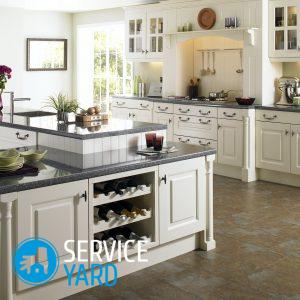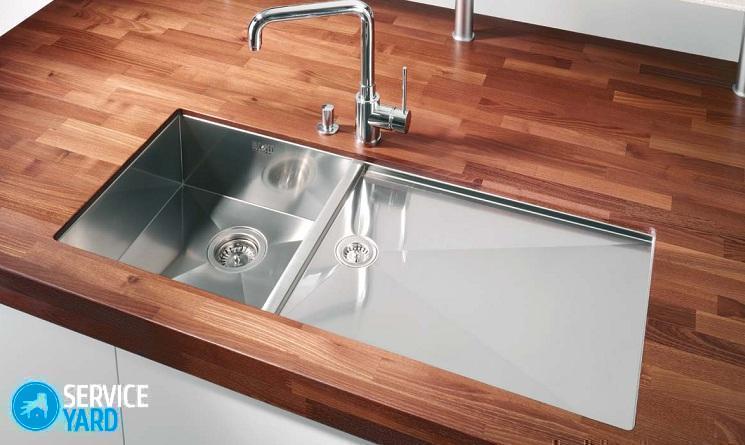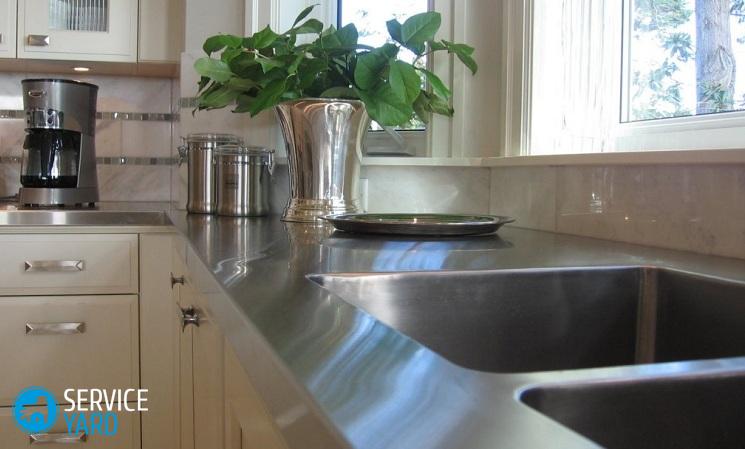What countertop to choose for the kitchen?

The kitchen is one of the most important rooms in any home. This fact can be confirmed by men, the path to the heart of which, as you know, lies through the stomach, and women who spend a lot of time in the kitchen. Each hostess has her own ideas about the functionality and beauty of the workplace. But the question of which countertop to choose for the kitchen depends not only on her personal wishes, but also on the financial capabilities of the family. Let's look at the types of countertops that are presented in stores, and try to find out how they differ from each other.
to contents ↑What type of countertop is better?
Countertops can be divided into groups in this way:
- By price.
- Material Composition:
- Laminated with plastic HLP.
- Products from acrylic artificial stone (Akrilika, Staron, Corian).
- Made of artificial stone filled with quartz.
- Of natural natural stone.
- From solid wood of noble breeds.
- Physical characteristics.
The front edge of the countertops can be made in different ways:
- The blockage is the radial rounding of the plastic from the working surface to its end.
- Blockage with a hem - plastic from the end is bent under the lower part of the countertop.
- Also, the end can be decorated with a 3D edge ABS or aluminum profile.
to contents ↑Important! A butt with a 3D edge is usually used for curved kitchens that have a radiused facade.
What countertop to choose for the kitchen? - We select material
Consider some of the features of the most popular materials so that you can understand what would be preferable for you.
Fake diamond
Wondering which tabletop is best for the kitchen, today many choose options made of artificial stone. The basis for this countertop is plywood, on which an artificial stone is glued, usually 12 mm thick.
Important! If you do not know which worktop to choose for a kitchen made of artificial stone, pay attention to famous brands - Akrilika, Staron, Montelli, Corian.
Properties:
- This material is plastic, so at high temperatures it is possible to create various bent shapes from it, which often becomes necessary for kitchens with radiused facades.
- Artificial stone is made of polymer glue and colored granules in order to simulate the composition of natural stone.
- These types of countertops are presented in a wide range of colors.
- The lower the price of countertops made of artificial stone, the more fragile and less ductile the material, so a bent shape can not always be given. But countertops made of cheaper material can be used for direct kitchens.
- The main advantage of this material is the ability to connect countertops without visible joints. The butt can be done using all kinds of curly shapes.
Important! This stone is warm to the touch, which cannot be said about the natural.
Quartz Agglomerate
The composition of such countertops is quartz, granite or mirror chips, as well as polymer binder resins. Plates for products from quartz agglomerate are produced under vacuum at high temperatures on special vibrating tables.
Important! As a rule, the thickness of the plate is 30 mm.
Air does not get into the material used for countertops, which makes it resistant to liquids, does not absorb acids and solvents, and this is a huge advantage over natural stone. In addition, quartz agglomerate is resistant to scratches and fractures.
Important! Thanks to modern technology, the junction of the countertops can be made almost imperceptible.
A natural stone
Natural stone products look thoroughly and respectably in the classic interior. The material for these countertops are sheets of stone blocks mined from the bowels of the earth.
What countertop to choose for the kitchen? Often, granite is used for kitchens, it is less hygroscopic and more dense than other types of stone. Granite does not absorb water, but it needs special care. The downside is the large weight and high price of such countertops.
Important! It is not recommended to use marble for kitchen worktops, because this material is easily dirty and scratched.
Natural wood
Natural wood products are beautiful and durable, but need special care. Often they are made from beech, oak, merbau, teak, wenge. Such countertops must be regularly treated with special protective solutions based on oils.
to contents ↑Important! You can wipe the surface only with a damp cloth, without the use of household chemicals.
Alternatives
If for some reason, choosing a countertop for the kitchen,
wood, stone or chipboard products are not suitable for you, you can choose the option of ceramic tiles, stainless steel or glass.
Stainless steel
Of course, products from this material are practical, however, it is hardly suitable for creating a warm cozy atmosphere. Such a surface is resistant to the appearance of the fungus, it is not afraid of temperature changes and high humidity.
These are the options that are used in restaurants, because they are easy to care for. You can wash such surfaces with various means, so you can keep your kitchen clean.
Important! The disadvantage of this countertop is that it needs to be polished from time to time, and this may entail additional costs.
Glass
At home, this material is rarely used for kitchen worktops. The reason is the low wear resistance of the material, the high price and the difficulty in maintenance. But this is offset by a spectacular appearance. Therefore, if the financial issue does not really matter to you, and you can afford to replace the product in a year, why not install it?
Ceramic tile
It is also sometimes used as a cover for countertops, however, it requires special care. Unfortunately, the material is not without drawbacks - the grout is unstable to external influences, and cracks and chips may appear on the tile itself. But the performance of a countertop covered with ceramic tiles can be improved by coating the surface with enamel.
to contents ↑Determine the optimal size
To understand which countertop to choose for the kitchen, you need to decide on the width, thickness, material and color.
Important! When designing kitchen furniture, you must remember that a countertop is initially a functional element, and only then a design one. Therefore, it is necessary to correlate the dimensions of the kitchen worktop with the layout, ergonomics of work processes, the placement of work areas, as well as ensuring the safety and comfort of family members.
Height
This parameter is very important, since the convenience of working in the kitchen will depend on it. The height should be determined when taking into account the height of the person who will be engaged in cooking, so that during the work he does not have pain in the lower back and legs:
- If a person’s height is below 150 cm, the desired height of the countertop is 76 cm.
- With a growth of about 160 cm, it is desirable to set the countertop to a height of about 83 cm, and with a growth of about 170 cm, to a height of 88 cm.
- In the event that the growth of family members is approximately 180 cm - the recommended height of the kitchen worktop is 91 cm, and with growth above 180 cm - 94 cm.
- For tall people whose height exceeds 190 cm, the height of the countertop should be at least a meter.
Important! Recommended sizes in each case under consideration require additional analysis. It should be borne in mind that the growth of all family members is different, so the selection of height requires an individual approach.
Width
It is necessary to take into account the ratio of the width of the countertop and the existing distance from its surface to the hanging cabinets.In case the width of the tabletop is from 65 cm, then the lower edge of the hinged furniture can be fixed at a height of about 50 cm from the table surface.
Important! If you cannot afford a wide countertop due to the small size of the kitchen, then convenience and visibility can be achieved due to the width of the hanging cabinets.
Thickness
You can choose a different thickness - from 2 to 6 cm:
- The standard thickness for chipboard countertops is 28 mm.
- The thickness of the moisture resistant product can reach up to 38 mm.
Installation and maintenance
Experts say that the shape of the countertops should be chosen based on the layout of the room, the configuration of the headset, as well as the organization of the working area.
Important! Try not to overload the kitchen with unnecessary corners - nothing should prevent it from moving around.
You can experiment with the material and color, because it is not necessary to use one color scheme or material. For example, natural stone combines wonderfully with ceramic tiles and mosaics, and wood with frosted glass. Also, an interesting design move is the illumination of the working area, because it is both beautiful and very convenient.
Also, choosing a countertop for a kitchen by quality, consider the cost of its installation:
- Laminated products are relatively inexpensive. They are fixed to the pipes using metal angles and screws. The skirting board covering the gaps between the tabletop and the wall is installed last.
- For wood products using brackets with oval slots are fixed with a "floating" method.
- Installation of countertops made of natural stone is an expensive and time-consuming process.
to contents ↑Important! As for care, you can wipe the surface of the countertop with a wet cloth in a circular motion.
Stock footage
Buying kitchen furniture, one way or another, is associated with a countertop. What it will be in shape, color, size, and what it will be made of is up to you. We hope that our article will help you understand the question of which countertop is better to choose for the kitchen.
- How to choose a vacuum cleaner taking into account the characteristics of the house and coatings?
- What to look for when choosing a water delivery
- How to quickly create comfort at home - tips for housewives
- How to choose the perfect TV - useful tips
- What to look for when choosing blinds
- What should be running shoes?
- What useful things can you buy in a hardware store
- Iphone 11 pro max review
- Than iPhone is better than Android smartphones





